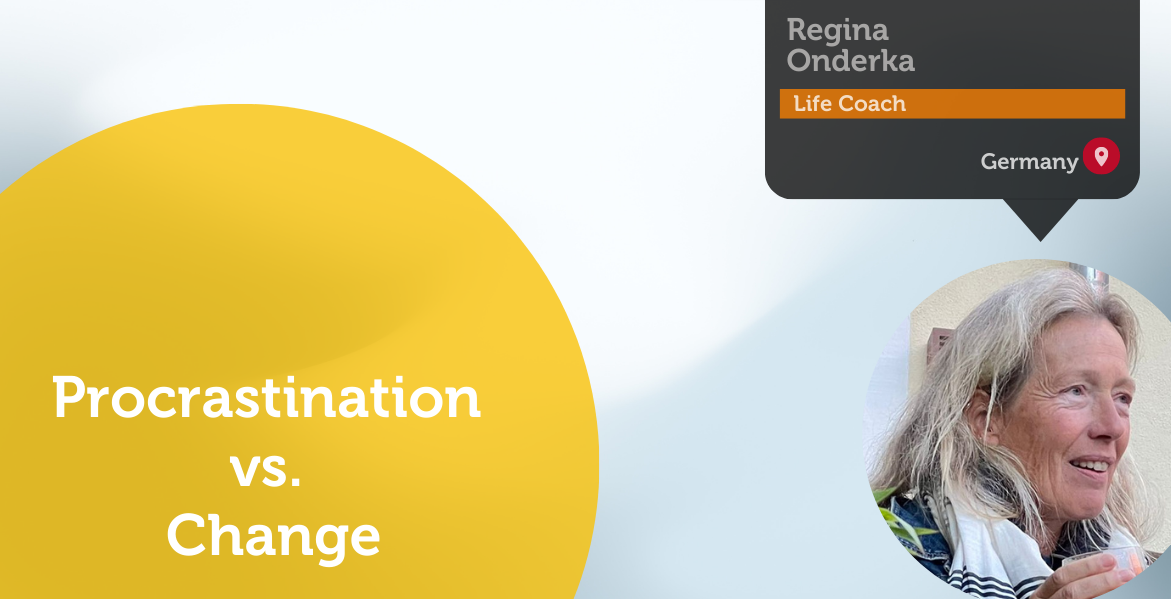A Coaching Power Tool By Regina Onderka, Change Coach, Life Coach, GERMANY

Procrastination vs. Change: What Is Change About?
Most of us, at some point in our lives, have experienced a moment when we became aware of something that might turn our current world upside-down.
Let’s think about a big change, something that has had an impact on us. What were our initial emotions? What came up?
Most of us will probably say that, at that moment, ‘it did not feel good’– as simple as that.
When we are confronted with change, particularly perceived negative changes, the moment of truth hits us. Most of the time, our first reactions and emotions are shock, anger, and denial with thoughts such as ‘This can`t be!’, ‘Why me?’, ‘What is the reason for this?’ and why is it happening at all?’
Sometimes, it is even more extreme, and we respond with either “Fight” or “Flight”. This is an automatic physiological reaction to an event, which is perceived as stressful or frightening. The perception of threat activates the sympathetic nervous system and triggers an acute stress response, which ultimately prepares the body to fight or flee the situation.
In most cases, very few people will initially welcome unexpected change with positive emotions of happiness, excitement, or courage.
Is Change Negative? What Does Change Management Tell Us?
A well-known model used in change management is the Change Curve, developed by a Swiss-American psychiatrist, Elisabeth Kübler-Ross, in 1969 and subsequently widely used, adapted, and changed. It depicts the 5stages of grief – denial, anger, bargaining, depression, and acceptance. This model is still very valid today, and the initial reactions to change are still the same.
This change curve is often used in a business context i.e., for the transformation of teams or businesses (or both), restructuring projects, and cultural change projects, however, it is equally applicable to any personal changes – and let’s face it, every change is personal and with every change comes grief.
When working with this model, in my role as an Organisational Development and Change Professional, we focussed a lot on the very first (and very naturally spontaneous) negative reactions to change, from the people and teams we worked with. The space we presented to express their emotions was key in helping people to feel heard. Offering a safe space to open up, raise concerns and, ultimately, support individuals to fully understand where those feelings are coming from was essential. Only then could we start to move forward, explore opportunities and possibilities, ask positive questions to confirm what worked well, and, most importantly, focus on people’s strengths. With this in mind, we were able to pave the way forward, create interest in the new normal, and see the potential options ahead.
Every change encompasses a behavioural adjustment – unlearn old habits, pick up new habits, learn new ways of interacting, let go of the past and embrace change.
There is a quote from Abraham Maslow says,
In any given moment we have two options: to step forward into growth or step back into safety.
Many people decide to stay where they are. The feeling of what we know well and what feels safe is often holding us back -even though the situation or the state of mind we`re in isn`t helpful, healthy, or promising any more. It is a challenge to let go and step forward into growth.
What Perspective Do We Cultivate in Those Phases?
Procrastination vs. Change Definition
Procrastination
Procrastination is the action of unnecessarily and voluntarily delaying or postponing something despite knowing that there will be negative consequences for doing so (Wikipedia).
Referring back to the initial reactions of ‘shock’ and ‘anger’ when confronted with change, these emotions happen at the moment and are measurable in a way. ‘Denial’ and even ‘depression’ are stages that might follow, whilst we are still processing the impact that the change will have on us. Typically, we weigh up how much we can accept what is coming our way.
We usually know, or at least we get an idea of, what we should or could do. We unconsciously often know what might work and what could move us forward.
What Is Hindering Us From Engaging With the Change and Taking Action?
The answer is: mostly fear and anxiety about what the new way of behaving might entail. In addition, we might worry about what we feel we have to give up. Is it a fear of losing control, or a fear of failing? In those situations, unfortunately, our brain is blocked, and we are far away from thinking about what we might gain. Instead of this, we only think about the loss.
Maintaining the status quo provides safety – at least we know what we know and we know how to do it.
There is also a positive aspect of procrastination
says Organisational Psychologist Adam Grant. According to Grant, moderate procrastination can help give your brain time to mull over a task or problem and create space for greater creativity and innovative ideas.
Assuming that overcoming the stage of procrastination will lead to greater awareness and learning, moving forward at some point is key.
Still, if we consider procrastination as a limiting belief, let’s allow ourselves to use this learning as a segue towards forming a different – positive and powerful – perspective.
Change
Change as personal development, or personal change is defined as activities that improve awareness and identity. (Wikipedia)
In an article on the web from «psych central» (Author: Ashley Carucci, September 2022), change is described as a process in which your personality is shaped by a dynamic relationship between your interactions, temperament, and environments …
… Change is a sustained reinforcement of new behaviours and thinking patterns.
Change is not negative – it`s our choice of how we see it and which perspective we chose to take.
What Can We Do to Flip It – From Procrastination to Change?
What would our thinking look like, if we cultivated a positive perspective and consider change as a liberating belief?
- Change is possible – we have a choice and we have chances
- We are independent and autonomous
- We are ok and, in every single moment, what happens is ok – we cannot change the past, nor predict the future, just be in the present
- Change needs time – small steps will help
- We know that procrastination is very normal and the more we are aware of its negative impact, the sooner we will want to change
- We are free to use the positive aspect of procrastination to overcome our perceived stagnation (i.e., mull over a task or problem, and create space for greater creativity and innovative ideas)
- We use this awareness to embrace change and use it as a liberating belief

A Way to Picture It:
Let`s take a look at these 2 dogs– sitting on the stairs, holding on to each other. Observing something, limited by the walls in front of them.
Let`s picture ourselves for a moment. What comes up for you? Do you feel safe? Do you feel you want to change your position?
Maybe you want to change, but you also have something that makes you feel safe and hinders you to move.
Or you don`t want to move, as it feels nice and cosy where you are – is that true? What is your current thinking?
 And now picture this
And now picture this
You are asked to change? What feelings come up now – still holding on to the current state? Are you getting insecure?
Thinking, considering – what doubts come up – what is still holding you back? Anxiety? False security?
The well-known? The risk of failing?
Or simply the new and unknown. But what if …
Look at this:

How liberating could it be to start jumping – kick-off the process of change – and explore what is in it for me?
How liberating as we have a choice and there will be chances.
Procrastination vs. Change Is a Choice
Change is there and we can decide how we think about it. Change is inevitable and will happen constantly. We have a choice to stay, with our old habits and behaviours.
And either it is because procrastination in its negative form is hindering us, or we simply need more time until we will take action.
We have a choice to change our perspective and accept change as it is – a chance for personal development, growth and learning.
Some of us think holding on makes us strong, but sometimes it is letting go! – Hermann Hesse
and
References
The Change Curve
Quote Abraham Maslow
Definition of procrastination
The Positive aspect of procrastination – Article Devry University.
Definition of Change, Wikipedia
An article, Psych Central; Can Someone Really Change Their Behaviors, Traits, and Habits?
All dog pictures used are privately taken and show my own dogs.